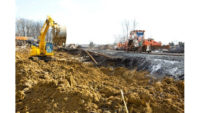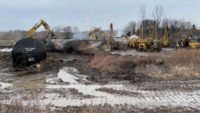An overheated bearing on a rail car axle played a critical role in the Feb. 3 Norfolk Southern train derailment and chemical spill in East Palestine, Ohio, according to the National Transportation Safety Board preliminary report on the incident.
The Feb. 23-released report comes amid increasing federal government pressure on Norfolk Southern to conduct and pay for a comprehensive cleanup of the derailment site and the surrounding area.
Having taken the lead of what it calls a longer-term remediation phase involving multiple agencies, the U.S. Environmental Protection Agency on Feb. 21 issued an administrative order under the Comprehensive Environmental Response, Compensation and Liability Act requiring Norfolk Southern to “identify and clean up contaminated soil and water resources.”
The railroad announced on Feb. 22 that it would modify its remediation plan to include soil excavation and replacement of both tracks in the derailment area—going beyond the original strategy prepared for it by Arcadis US. Citing the input of East Palestine residents, the railroad now says soil preparation along the first rail line will begin immediately, followed by soil excavation and track removal and rebuilding. The same process will then follow for the second track.
No timeline was given for the process, but Norfolk Southern added that trains will continue running at slower speeds on one track while the other is removed and rebuilt.
No Track Defect Seen in Derailment
The preliminary board report identifies a suspect bearing, located on an axle in the twenty-third car of the 150-car train, which was recorded at 250°F above the ambient temperature when a wayside defect detection system sent an audible alarm alerting the train crew to stop and perform a visual inspection, per Norfolk Southern procedure.
To slow the train down from just under the track’s 50-mph speed limit, the engineer increased dynamic breaking that had already been applied to maintain a safe distance behind another train. The derailment occurred as the train decelerated, triggering an emergency brake application that brought the entire train to a stop.
Observing fire and smoke, the train crew received authorization from the railroad’s dispatcher to uncouple and move the head-end locomotives approximately one mile away from the remainder of the train, the report says. The 38 derailed cars included 11 tankers carrying vinyl chloride and other hazardous materials that subsequently ignited, fueling fires that damaged 12 non-derailed railcars.
NTSB Chair Jennifer Homendy told a press briefing that investigators had found no track defects or operational issues with the infrared-based wayside defect detectors, which indicated that the bearing’s temperature rose by more than 200°F above ambient temperature over a 20-mile span. Surveillance video from a nearby residence indicated what the report says was “a wheel bearing in the final stage of overheat failure moments before the derailment.”
NTSB says that its ongoing investigation will focus on the suspect wheelset and bearing, tank-car design and derailment damage, as well as Norfolk Southern’s use of wayside defect detectors, including its threshold for addressing overheating issues. The railroad defect alarm threshold criteria calls for trains to stop for inspection for “warm bearing (non-critical)” conditions of between 170°F and 200°F above ambient temperature.
Noting that threshold and response criteria vary by railroads, Homendy said the train crew was following proper procedure as radio announcements of the bearing’s rising temperature came in.
Additionally, NTSB will review the accident response, including the venting and burning of the vinyl chloride that local residents say fouled area air quality. “We’ll evaluate if it was carried out according to [Federal Railroad Administration] guidelines, and if that guidance needs to be updated,” Homendy said.
The board will also hold a rare field investigative hearing in East Palestine this spring during which members will question Norfolk Southern and other invited witnesses. While a final report with a probable cause may take 12 to 18 months to issue, Homendy said that if the investigation identifies a safety issue that needs immediate attention, “we won’t hesitate to issue an urgent safety recommendation.”
Cleanup Efforts Progress at Site
Norfolk Southern says it has already removed more than 4,800 cu yd of soil from the derailment site, the first loads of which will be shipped to an approved disposal facility within the next two weeks. An estimated 1.7 million gallons of liquid has also been collected, which is being transported for disposal. Soil and water testing around the site also continues.
AECOM has confirmed that it is performing potable water sampling of East Palestine’s system and residential wells on behalf of Norfolk Southern.
The Ohio Environmental Protection Agency has assured East Palestine residents that municipal drinking water system groundwater sources are safe, but surface water sources are a different story. A recent agency update characterized water in Sulfur Run, near the derailment site, as “grossly contaminated.” The state environmental agency added that clean water from upstream is being pumped around the containment area to isolate any grossly contaminated water and sediments prior to removal.
Downstream from East Palestine, Ohio River water samples collected on Feb. 18 to 19 by the Ohio River Valley Water Sanitation Commission and analyzed by Greater Cincinnati Water Works indicate derailment-related contaminants remain below detectable levels. Cincinnati has also reopened its water intake, which was closed as a precautionary measure, as water from East Palestine moved through the area.
U.S. Transportation Secretary Pete Buttigieg, who visited East Palestine on Feb. 23, has called for Norfolk Southern and other railroads to take immediate measures to improve rail safety, including continued inspections by workers even as new technologies are deployed—a move the industry has resisted.




Post a comment to this article
Report Abusive Comment